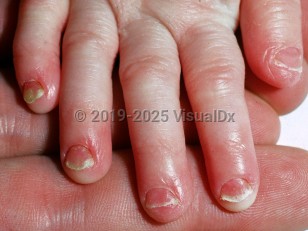- Photosensitivity
- Ichthyosis
- Brittle hair
- Intellectual impairment with low IQ
- Decreased fertility
- Short stature
Approximately half of TTD patients experience photosensitivity due to a defective nucleotide excision repair. Mutations in ERCC2, ERCC3, and GTF2H5 genes producing XPB, XPD, and p8/TTDA subunits of the general transcription factor IIH (TFIIH) are responsible for photosensitive TTD. The ineffective DNA repair likely leads to photosensitivity. Although less frequent, non-photosensitive TTD patients have been shown to have mutations in TTDN1 or MPLKIP, genes of unknown function.
Ichthyosis
Dry, scaly, and/or thickened skin was reported in 65% of patients (out of 112 in a review).
Brittle hair
Short, brittle hair due to sulfur deficiency is a diagnostic characteristic of TTD. It results in "tiger tail" banding in the hair – alternating light and dark bands seen under polarizing light. Hair may be sparse and alopecia may be seen.
Intellectual impairment
Most patients have a form of intellectual impairment, such as failure to reach developmental milestones and low IQ. Microcephaly, abnormal gait, and increased tendon reflexes have also been reported. On neuroimaging, some TTD patients demonstrated impaired development of the brain with features such as demyelination and cerebellar atrophy.
Decreased fertility
Up to 14% of patients experienced sexual / reproductive abnormalities, primarily hypogonadism. Fertility is decreased. Of those who achieved gestation, approximately half experienced pregnancy complications, such as preeclampsia, and around 50% of the infants had abnormal birth characteristics, such as low birth weight, premature birth, collodion membrane, and congenital cataracts, usually indicating TTD inheritance in the baby.
Short stature and facial abnormalities
TTD patients generally have a short stature and an unusual facial appearance, including a beaked nose, protruding ears, and a receding chin.
Additional systemic features observed
- Recurring infections, predominantly respiratory, contributing to increased neonatal and childhood morbidity and mortality
- Ocular abnormalities, primarily cataracts at all ages
- Seizure disorder, primarily in patients with a mutated TTDN1 gene
- Dental abnormalities and caries
- Cardiac and hepatic abnormalities



